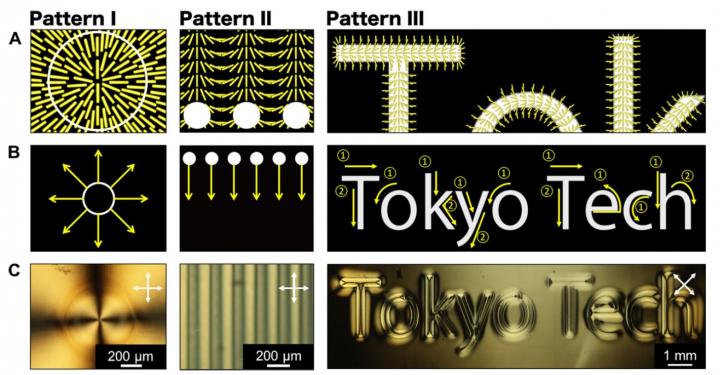Photopolymerization-triggered molecular motion for flexible liquid crystal display

A represents a schematic illustration of the desired patterns of alignment. B represents irradiated light patterns of expanding toroid shapes, periodic dots, and the words Tokyo Tech. C represents POM images under crossed polarizers. Credit: Atsushi Shishido, Tokyo Institute of Technology
Currently, only two approaches to dye-free methods have been explored. The first is a two-step alignment method, in which the liquid crystal materials are coated over a very thin dye-containing photoalignment layer and then aligned or fixed by polymerization.
While this method has proven very successful in achieving stimuli-responsive 2D aligned liquid crystals and elastomers used in photonics, solar energy harvesting, microfluidics, and soft-robotic devices, it is expensive and time-consuming.
The creation of a film with microscopic arrays of microalignment patterns requires precise and dynamic control of the polarized direction of incident light in each pixel, so this method is unsuitable for aligning patterns on the nanoscale over large areas.
The second approach to the development of a dye-free system uses surface topography to overcome the limitations of conventional photoalignment. In this method, the liquid crystals are aligned over a surface topography template through lithography, nanoimprinting, or inkjet techniques among others.
While this method allows for 2D micropatterning of molecular alignment, it still requires multi-step processing, making it costly and time-consuming. Due to the surface roughness from the topographic templates, this method proves difficult in the production of thin films.
A research group led by Atsushi Shishido at Tokyo Tech has reported the development of a new method of scanning wave photopolymerization that utilizes spatial and temporal scanning of focused guided light. As the polymerization reaction proceeds, a mass flow in the film is triggered, and this results in alignment of the liquid crystals with the incident light patterns. The desired alignment is achieved through a single step by light triggered mass flow.
This new method generates arbitrary alignment patterns with fine control over larger areas in a wide variety of liquid crystal materials without the need for strong dyes or additional processing steps, something that previous methods were unable to achieve. This method has the additional advantage of unlimited complexity in 2D patterns that would, in principal, only be restricted by the light diffraction limits.
This new concept of scanning wave photopolymerization is currently limited to photopolymerizable liquid crystal systems with a thickness below tens of micrometers. However, further investigation can expand material systems that could be used such as nanorods, nanocarbons, and proteins.
Scanning wave photopolymerization can be readily introduced into existing photoproduction facilities, allowing for great economic advantages. The scientists at Tokyo Institute of Technology see this method as a powerful pathway for the simple creation of highly functional organic materials with arbitrary, fine molecular alignment patterns on the nanoscale over large areas.
Media Contact
All latest news from the category: Power and Electrical Engineering
This topic covers issues related to energy generation, conversion, transportation and consumption and how the industry is addressing the challenge of energy efficiency in general.
innovations-report provides in-depth and informative reports and articles on subjects ranging from wind energy, fuel cell technology, solar energy, geothermal energy, petroleum, gas, nuclear engineering, alternative energy and energy efficiency to fusion, hydrogen and superconductor technologies.
Newest articles

Superradiant atoms could push the boundaries of how precisely time can be measured
Superradiant atoms can help us measure time more precisely than ever. In a new study, researchers from the University of Copenhagen present a new method for measuring the time interval,…

Ion thermoelectric conversion devices for near room temperature
The electrode sheet of the thermoelectric device consists of ionic hydrogel, which is sandwiched between the electrodes to form, and the Prussian blue on the electrode undergoes a redox reaction…

Zap Energy achieves 37-million-degree temperatures in a compact device
New publication reports record electron temperatures for a small-scale, sheared-flow-stabilized Z-pinch fusion device. In the nine decades since humans first produced fusion reactions, only a few fusion technologies have demonstrated…





















